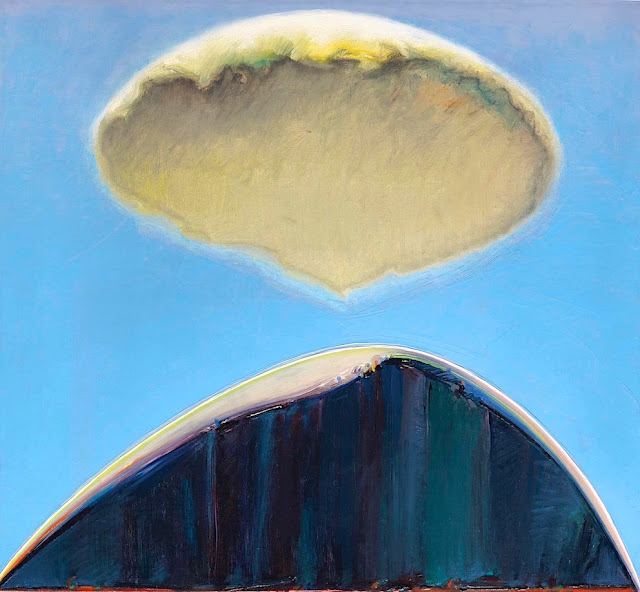Half Dome / Tis-sa-ack (2, 695 m - 8,844 ft)
Etats-Unis d'Amérique (Californie)
The MET, New York
Le photographe
Ansel Easton Adams est un photographe et écologiste américain, connu pour ses photographies en noir et blanc de l'Ouest américain, notamment dans
la Sierra Nevada, et plus particulièrement du parc national de Yosemite.
Une de ses plus célèbres photographies s'intitule Moonrise, Hernandez, Nouveau-Mexique. En collaboration avec Fred Archer, Adams développa le zone system,
procédé qui permet de déterminer l'exposition correcte ainsi que
l'ajustement du contraste sur le tirage final. La profondeur et la
clarté qui en résultent sont la marque de fabrique des photographies
d'Ansel Adams et de ceux à qui il a enseigné la technique. Dans un
premier temps, Adams utilisera des appareils photographiques grand
format (plus que 4 × 5 pouces), qui malgré leur taille, leur poids, le
temps de mise en place et le prix des films sont un bon moyen, de par
leur résolution élevée, de s'assurer du piqué de l'image. Adams fonda le
Groupe f/64 avec ses amis photographes Edward Weston et Imogen
Cunningham, qui à leur tour, mettront en place le département de la
photographie au sein du Museum of Modern Art.
Les photographies intemporelles et visuellement saisissantes d'Ansel
Adams sont de nos jours encore reproduites sur une grande variété de
supports : calendriers, posters, livres, faisant de ses clichés des
images célèbres et reconnaissables. Une réserve de nature sauvage porte
désormais son nom, au sud du parc national de Yosemite, en Californie.
Half Dome / Tis-sa-ack (2, 695 m - 8,844 ft) « Demi Dôme » en anglais, " roche fendue » en langage amérindien, est un dôme granitique situé à l’extrémité est de la vallée de Yosemite, sans doute l’élément le plus célèbre de la vallée. Le sommet se situe à plus de 1 440 mètres au-dessus du niveau de la vallée. Half Dome est un excellent exemple de dôme d'exfoliation. Il ne fut probablement jamais un dôme complet et rond. Quand le Half Dome s’est formé, il avait déjà des fractures dans le granite. L’eau s’infiltra dans les fractures et gela, cassant la roche. Des glaciers érodèrent la base du dôme. Finalement, environ 20 % du dôme fut emporté par le glacier Tenaya, laissant derrière lui une paroi presque verticale.
Jusque dans les années 1870, on considérait que le Half Dome ne pouvait être grimpé. De nos jours, des milliers de randonneurs atteignent le sommet chaque année par la « voie normale avec les câbles ». Un itinéraire qui part du fond de la vallée et fait 13,5 kilomètres (8,5 miles) pour 1 500 mètres de dénivelé positif, avec une difficulté de « randonnée alpine » (T4). Les derniers 200 mètres d'ascension sont une dalle très inclinée (30°) équipée de câbles métalliques (posés en 1919).
D’autre part, il existe une douzaine de voies d’escalade qui mènent de la vallée au sommet à travers la face verticale nord-ouest du Half Dome. D’autres itinéraires escaladent la paroi sur la face sud et la paroi ouest. La première voie ouverte était la voie Regular Northwest Face (voie normale de la face nord-ouest), grimpée pour la première fois en 1957 par Royal Robbins, Mike Sherrick et Jerry Gallwas. Cette ascension dura 5 jours et fut la première voie de niveau VI aux États-Unis. Depuis, cette montagne f a été le témoin d'un autre grand exploit sportif. Le 6 septembre 2007, la jeune figure montante de l'escalade en solo, Alex Honnold, a grimpé le Regular Northwest Face (voie de plus de 700 mètres (23 longueurs de corde) cotée 5.12a) sans aucune protection en seulement 2 heures et 50 minutes.
_________________________________________
2023 - Wandering Vertexes ....
Errant au-dessus des Sommets Silencieux...
Un blog de Francis Rousseau
%20Moon%20and%20Half%20Dome,%20Yosemite%20National%20Park,%20California%201960,%20printed%201974%20Medium:%20Gelatin%20silver%20print%20The%20Metropolitan%20Museum%20of%20Art,%20New%20York%20(Gift%20of%20Ansel%20&%20Virginia%20Adams).jpg)





